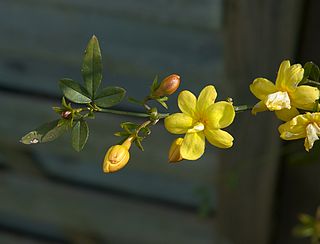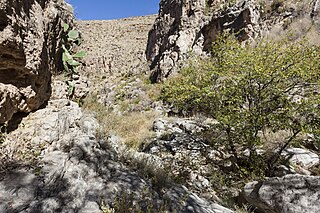
Fraxinus, commonly called ash, is a genus of plants in the olive and lilac family, Oleaceae, and comprises 45–65 species of usually medium-to-large trees, most of which are deciduous trees, although some subtropical species are evergreen trees. The genus is widespread throughout much of Europe, Asia, and North America.

Fraxinus albicans, commonly called the Texas ash, is a species of tree in the olive family (Oleaceae). It is native to North America, where it is found from eastern Texas and southern Oklahoma in the United States, to the state of Durango in Mexico. Its natural habitat is in dry, rocky slopes, often over limestone.
Jean-Louis Berlandier was a French-Mexican naturalist, physician, and anthropologist.

Fraxinus mandshurica, the Manchurian ash, is a species of Fraxinus native to northeastern Asia in northern China, Korea, Japan and southeastern Russia.

Fraxinus profunda, the pumpkin ash, is a species of ash (Fraxinus) native to eastern North America, where it has a scattered distribution on the Atlantic coastal plain and interior lowland river valleys from the Lake Erie basin in Ontario and New York west to Illinois, southwest to Missouri and southeast to northern Florida. It grows in bottomland habitats, such as swamps, floodplains and riverbanks. It is threatened by the emerald ash borer, an invasive insect which has caused widespread destruction of ash trees in eastern North America.

Spinulum annotinum, synonym Lycopodium annotinum, known as interrupted club-moss, or stiff clubmoss, is a species of clubmoss native to forests of the colder parts of North America, as well as Asia, and most of Europe. The genus Spinulum is accepted in the Pteridophyte Phylogeny Group classification of 2016, but not in other classifications, which submerge the genus in Lycopodium.

Abutilon fruticosum is a widespread species of flowering plant in the mallow family known by the common names Texas Indian mallow, pelotazo, and sweet Indian mallow. It is native to Africa, southern and southwestern Asia, northern Mexico, and the south-central United States.

Fraxinus hubeiensis is a species of ash native to Hubei province in China.

Jasminum mesnyi, the primrose jasmine or Japanese jasmine, is a species of flowering plant in the family Oleaceae, native to Vietnam and southern China. It is also reportedly naturalized in Mexico, Honduras and parts of the southern United States.
Prionosciadium nelsonii is a plant species known from the Mexican states of Chiapas and Morelos. It is a biennial herb with a large taproot. Leaves are compound with narrowly lanecolate leaflets, some of them with narrow, tapering lobes. The inflorescence is a compound umbel at the top of the stem.
Fraxinus cuspidata is a tree native to northern Mexico and the southwestern United States. It has been reported from Nuevo León, Coahuila, Chihuahua, Tamaulipas, Texas, New Mexico, Arizona and Nevada.

Galium proliferum, also known as limestone bedstraw, is a species of plant in the Rubiaceae family. It is native to Northeastern Mexico and the Southeastern United States. More specifically, it can be found in American states California, southern Nevada, southern Utah, Arizona, New Mexico, Texas, as well as the Mexican states Coahuila and Nuevo León.
Spermacoce glabra, smooth false buttonweed, is a New World species of plants in the coffee family.
Brickellia conduplicata, the southwestern brickellbush, is a species of flowering plant in the family Asteraceae. It is native to northeastern Mexico in the states of Tamaulipas and San Luis Potosí.
Brickellia hebecarpa is a Mexican species of flowering plants in the family Asteraceae. It is native to western Mexico, the states of Colima, Michoacán, and Jalisco.
Brickellia diffusa is a Latin American species of flowering plants in the family Asteraceae. It is widespread across much of South America, Central America, Mexico, Galápagos, and the West Indies. Its distribution stretches from Sonora and Tamaulipas in northern Mexico to Jujuy in northern Argentina.
Chromolaena squalida is a South American species of flowering shrub in the family Asteraceae. It is found in Brazil, Paraguay, Bolivia, Peru, Colombia, Venezuela, Guyana, Suriname.
Conoclinium dissectum, the palm-leaf mistflower or palmleaf thoroughwort, is a North American species of flowering plants in the family Asteraceae. It is native to northern Mexico and the southwestern United States.

Fraxinus uhdei, commonly known as tropical ash or Shamel ash, is a species of tree native to Mexico and Central America. It is commonly planted as a street tree in Mexico and the southwestern United States. It has also been planted and spread from cultivation in Hawaii, where it is now considered an invasive species.
Fraxinus papillosa, the Chihuahuan ash, is a species of flowering plant in the family Oleaceae, native to the deserts of Mexico and the southwestern United States. A small tree, it usually is found growing in canyon bottoms and on north-facing slopes.









